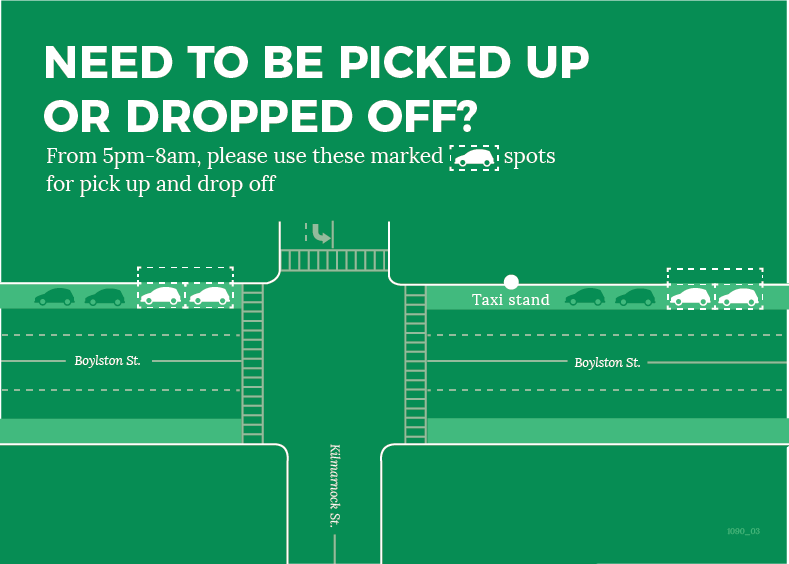Pick-up and drop-off pilot for passenger cars
The pilot program in the Fenway dedicates curb space for pick-ups and drop-offs for all passenger vehicles, including ride-hail vehicles like Uber and Lyft.
Our pilot zone was in the Fenway, on the northside of Boylston Street near Kilmarnock Street. We created spots for pick-up and drop-off activity in an effort to:
- ease congestion
- improve safety, and
- make it easier for drivers and passengers to find each other.
We are also hoping to make our limited curb space more efficient. We want to make sure people can safely access our curbs and sidewalks. The City will learn from this pilot to assess and determine whether we're meeting our objectives.
Pilot zone location
The pilot took place in the Fenway, on the northside of Boylston Street near Kilmarnock Street.
There are two sets of spaces, with a total of four spaces used for pickups and drop offs. The first set of two spaces is located on Boylston Street, directly to the west of Kilmarnock Street. The second set of two spaces on Boylston Street is located two parking meters down from the taxi stand, to the east of Kilmarnock Street.
How the program works
- The City installed signs to show that from 5 p.m. - 8 a.m., the spaces are for pick-up and drop-off activity only, and that drivers must stay in their vehicles.
- Uber and Lyft geofenced the northside blocks immediately to the west and east of Kilmarnock Street. They directed passengers in their respective apps to the pick-up and drop-off zones from 5 p.m. - 8 a.m.
The blocks highlighted in green below should be geofenced. At most, passengers may travel up to a block to use the zones.
From 5 p.m. - 8 a.m., anyone can use the spaces for pickups and drop offs. Outside of those hours, the spaces will be metered parking. Drivers must abide by all other posted regulations and signs.
Tickets may be issued to vehicles that are parked in the zone instead of being stopped for a pickup or drop off. Any tickets the City issues will be for parking while the zone is in effect. While the zone is in effect, the maximum time limit for pickups and drop offs is five minutes, and the driver must stay with the vehicle. Violations carry a $90 fine.
Initial assessment report
We learned a great deal from the pilot and have drafted an initial assessment report after collecting four months of data. We relied on both quantitative and qualitative methods. A few of the findings are listed below:
- Huge increase in curb productivity. The utilization rate of the curb increased by more than 350 percent in the pick-up/drop-off zone.
- Parking incidents decreased. We saw an eight percent drop in overall parking citations in the area.
- Safer behaviors observed. Observation data found a notable decrease in pick-up/drop-off activity happening in the travel lane after the zone was installed.
- Adding paint and signage. Painting the curb a different color may help drivers differentiate the space.
- Driver and passenger education and outreach. While at airports many travelers and drivers expect to see a pick-up/drop-off zone. But, it is less common on an a city block. We should consider outreach and education initiatives that help travelers and drivers identify these zones.




